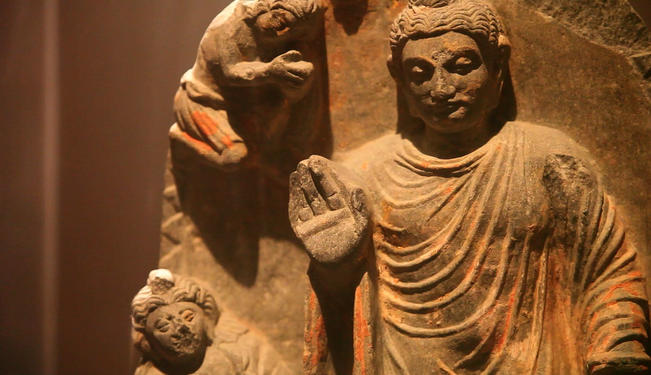What will the fate of Afghanistan's culture be? [Note: Read part one here.]
Fair Observer’s Central & South Asia Editor, Will Calhoun, speaks to Brent E. Huffman about the efforts to preserve Mes Aynak — a vast and rich archaeological site in Logar Province, Afghanistan.
Huffman, an award-winning documentary filmmaker and associate professor at Northwestern University’s Medill School of Journalism, has launched a project to save Mes Aynak. He also plans to release a documentary film about the site.
Will Calhoun: It seems like the start date for the mining has been pushed back. What is the new date?
Brent E. Huffman: My big fear is that the president of Afghanistan flew to Beijing to talk with MCC [China Metallurgical Group Corporation] and renegotiate the mining contract, partly because of the worsening security situation. The Afghans want the Chinese to get started, and the Chinese are having problems on the ground.
So Karzai recently went to China, maybe about two months ago, and I’ve only heard terrible things about this renegotiation — that a lot of the benefits to Afghanistan were taken out of the contract — and I’m assuming that there is a new start date in this agreement. Again, I don’t know the details of the contract, it has not been made available to me. I would be shocked if they didn’t start sometime in 2014, however. The new contract supposedly removes many of the promises that MCC initially made to the Afghan government, like an onsite smelter, railway system, roads, etc. The new contract also reduces royalties that will be paid to the Afghan ministry. So, all bad news.
Calhoun: How has the planned drawdown in US troops affected plans to excavate the site and mine copper? Has this created hesitancy on the part of the Chinese to remain at Mes Aynak?
Huffman: MCC is a government-owned entity in China and they receive all their orders from Beijing — they are quite powerful. This is just my opinion, as I have lived in China, but it would be very different for a US company. MCC feels its employees are expendable and the company is not liable for their safety. MCC has threatened to leave Mes Aynak, but I think those are empty threats and political power plays. The Chinese have set up in very dangerous areas: in Libya, in Iraq, many places where no one else would go. Mes Aynak is in Taliban territory, and no other country would set up in this area.
I do think the NATO/US military pullout has a negative effect. I think the region will become more dangerous, chaotic, and unstable. A part of me feels like the Chinese welcome this change. They have a long-term interest in Afghanistan, and there are supposedly $1-3 trillion worth of resources buried in Afghanistan: lithium, oil, copper, gold, iron, etc. The Chinese have a long-term interest in all these valuable resources, and Mes Aynak is sort of the first step for them. They want Mes Aynak to set this precedent. I think the Chinese companies will be glad when the US pulls out, since they can take the place of the US and build a relationship with Afghanistan so they can extract more resources.
I think getting teams of international archaeologists to work at Mes Aynak will become extremely difficult after the pullout. The Afghan archaeologists are amazing people and are doing incredible work, but they don’t have the level of specialization and they are sort of pawns of the government. They can be pushed around and not paid, while foreign archaeologists can’t be. I think that once the US and NATO exit from Afghanistan, all the incredible archaeological sites of the country will come under threat.
Calhoun: Is there a chance of saving anything of value from the site before it’s destroyed?
Huffman: Yes, there is good news. The kind of archaeology being done at Mes Aynak is rescue archaeology. We often think of salvage archaeology when people are doing extremely detailed studies of layers and layers of findings at a site. That’s not what they are doing at Mes Aynak. Rescue archaeology can be disruptive. Rescue archaeology is digging into something or breaking off pieces instead of saving the whole structure, and archaeologists are saving smaller items that can be put in a pickup truck. Items are being stored at the National Museum of Afghanistan, in Kabul, which was attacked by the Taliban in 2001 — entirely blown up — so it isn’t the safest place.
In making my film and running this awareness campaign, the success of raising awareness has been to give archaeologists more time and to show the Afghan government and MCC that the site has value and that the international community values the site and sees the importance of it. Those are sort of the small victories to give archaeologists more time.
Calhoun: You’ve said before that the US Embassy is encouraging the mining project, or at least not standing in the way of the Chinese. How and why have they been doing this?
Huffman: The World Bank and the US Embassy have been pushing for this mining to begin, and they wouldn’t speak with me for the documentary. This is just speculation, but the thinking is that the Chinese will bring infrastructure and jobs and private security to the area, and that this is a potential source of wealth for Afghanistan. It is odd to think that the US military is helping a Chinese company when they aren’t getting anything out of it. I find it very strange — this partnership between the US military and the Chinese.
The US has made a mess of Afghanistan on every level — it’s just a disaster, and they want to pull out. The initial thoughts were probably that the mining deal would benefit the country in the long-run. In my opinion, the money from the mining deal will be lost to corruption. This archaeological site will be destroyed and there will be massive environmental devastation. The area will be so polluted that no one will ever be able to live there. I am of the opinion that everything is going to be taken by the Chinese, and Afghans will not get the jobs.
Calhoun: What’s the current status of your documentary?
Huffman: I’m planning to finish it in the summer of 2014. I was recently awarded a large grant from the MacArthur Foundation that will help me complete the film and fund an awareness campaign at the same time.
Calhoun: How can people get involved in efforts to preserve Mes Aynak?
Huffman: There’s a petition on my Facebook page with almost 70,000 signatures, but I think the best thing would be if a celebrity or politician would speak up and say that the US should work to preserve Mes Aynak. I think that would really rally support. I think if we could get hundreds of thousands of signatures — that would really save the site.
The dream situation for me would be to save Mes Aynak and do a proper archaeological dig, save everything, and make it a tourist destination. But I think that will only happen with massive public support for the site, and UNESCO would have to come in and assist archaeologists.
Sadly, when the Taliban blew up the Buddhas of Bamiyan, people were horrified and shocked and it really rallied them. However, it was too late. My fear is that the same thing will happen with Mes Aynak, that there will be silence until it is destroyed and then there will be outrage.
But yes, people can come to my Facebook page and sign the petition. I’ve given money to the Afghan archaeologists to finally buy them computers and digital cameras. They had been working for years with neither. The Afghan archaeologists are the unsung heroes in this story — they have been working in terrible and dangerous conditions, so people can also donate to the film to help the archaeologists.
The views expressed in this article are the author's own and do not necessarily reflect Fair Observer’s editorial policy.
Support Fair Observer
We rely on your support for our independence, diversity and quality.
For more than 10 years, Fair Observer has been free, fair and independent. No billionaire owns us, no advertisers control us. We are a reader-supported nonprofit. Unlike many other publications, we keep our content free for readers regardless of where they live or whether they can afford to pay. We have no paywalls and no ads.
In the post-truth era of fake news, echo chambers and filter bubbles, we publish a plurality of perspectives from around the world. Anyone can publish with us, but everyone goes through a rigorous editorial process. So, you get fact-checked, well-reasoned content instead of noise.
We publish 2,500+ voices from 90+ countries. We also conduct education and training programs
on subjects ranging from digital media and journalism to writing and critical thinking. This
doesn’t come cheap. Servers, editors, trainers and web developers cost
money.
Please consider supporting us on a regular basis as a recurring donor or a
sustaining member.
Will you support FO’s journalism?
We rely on your support for our independence, diversity and quality.







Comment